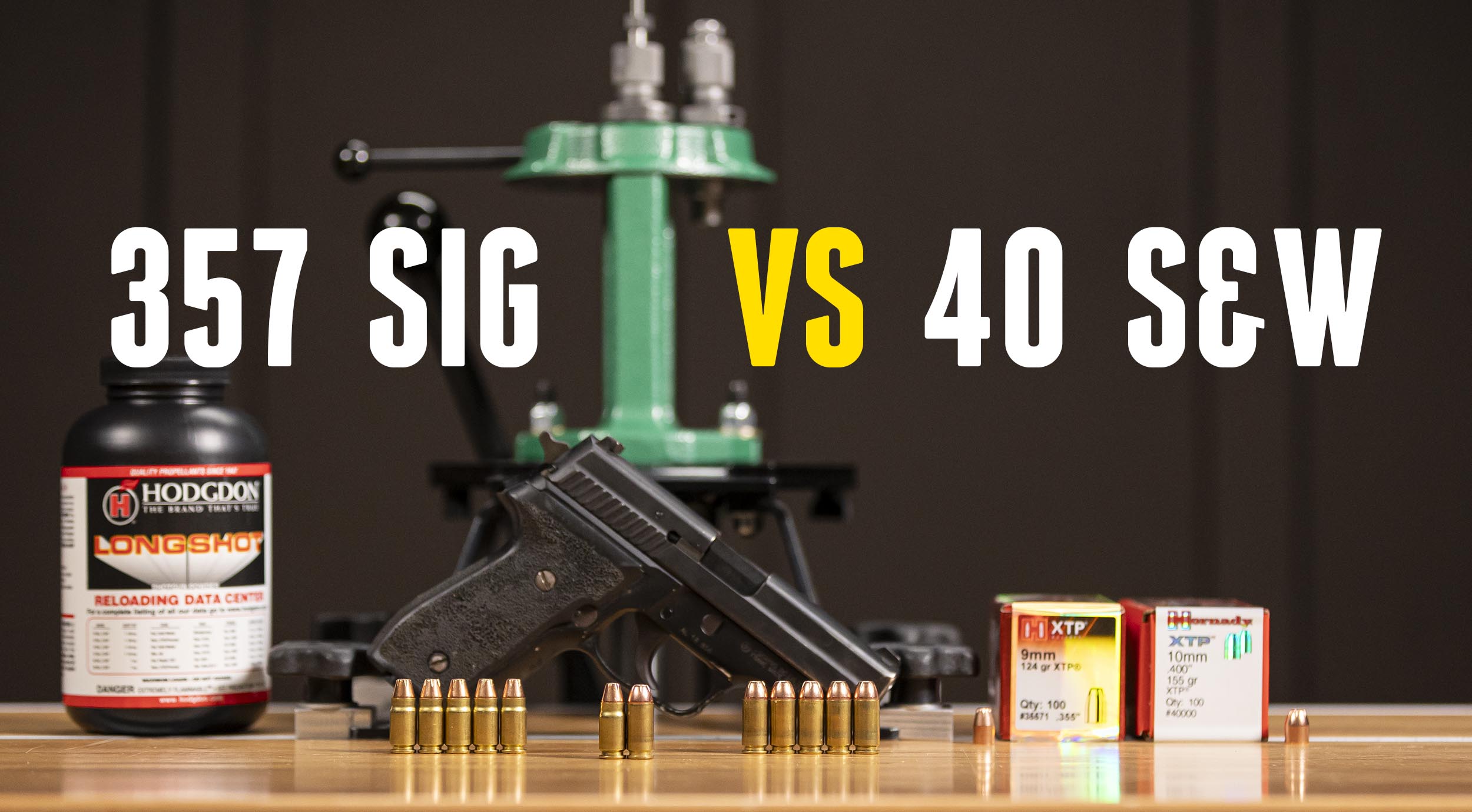Next in our head-to-head series: .40 S&W vs. .357 SIG. Both of these cartridges were incredibly popular with law enforcement in the 1990s. Today, not so much. What happened and which of the two is superior? Watch or read on to find out!
Disclaimer
Ultimate Reloader LLC / Making with Metal Disclaimer: (by reading this article and/or watching video content you accept these terms). The content on this website (including videos, articles, ammunition reloading data, technical articles, gunsmithing and other information) is for demonstration purposes only. Do not attempt any of the processes or procedures shown or described on this website. All gunsmithing procedures should be carried out by a qualified and licensed gunsmith at their own risk. Do not attempt to repair or modify any firearms based on information on this website. Ultimate Reloader, LLC and Making With Metal can not be held liable for property or personal damage due to viewers/readers of this website performing activities, procedures, techniques, or practices described in whole or part on this website. By accepting these terms, you agree that you alone are solely responsible for your own safety and property as it pertains to activities, procedures, techniques, or practices described in whole or part on this website.
Semi-Automatic Pistols for Self-Defense: A Brief History
Many people don’t realize how long semi-automatic pistols, and many of the cartridges for them, have been around and in use. The introduction of smokeless powder spurred the development of several semi-automatic pistols in the 1880s and 1890s, mostly in Germany and Austria. Perhaps the most successful of these was the Mauser 1896—often nicknamed the “Broomhandle Mauser ” for its appearance. More than a million were made over its 40 years of production.
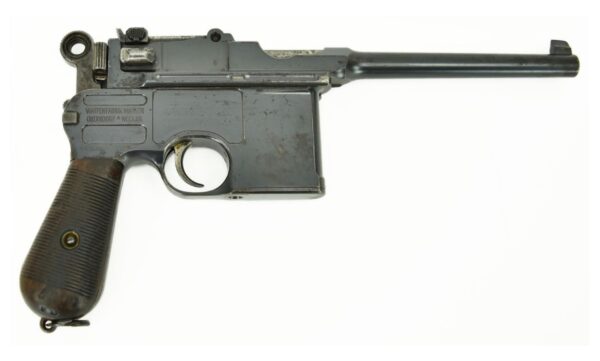
By 1902, the German Luger pistol and the 9mm Parabellum cartridge had arrived! (Yes, the 9mm Luger is older than the .45 ACP…)
Here in the USA, John Moses Browning developed the Colt Model 1900 in .38 ACP, and eventually the more powerful .380 ACP. The U.S. Army wanted a more powerful pistol to replace the older revolvers they were using and adopted the Colt .45 ACP in 1911. It’s interesting that the 9mm Parabellum and .45 ACP, two very popular semi-automatic cartridges, were introduced well over 100 years ago. They are still going strong, better than ever!
Semi-Automatics for Self-Defense: Considerations
Semi-automatic pistols can be excellent for self-defense. They are easily capable of rapid fire and are very quick to reload. The physical size of the pistol is of extreme importance as they vary considerably in size and weight. A smaller pistol is easier to conceal, but can be difficult to shoot well. The short sight radius, small grip, and lack of weight all conspire against accurate shooting.
A full-size semi-automatic can be difficult to conceal, particularly in warmer months, but it is possible if care is taken to dress accordingly. Much of this is due to the “flat” design of semi-automatics. Bigger guns typically offer a larger, more comfortable grip; a longer sight radius; more weight to offset the recoil; and superior sights. All that adds up to a gun that is easier to shoot well—as long as the user can handle the power of the cartridge. If the handgun isn’t going to be concealed (ex. nightstand gun), then size is less important.
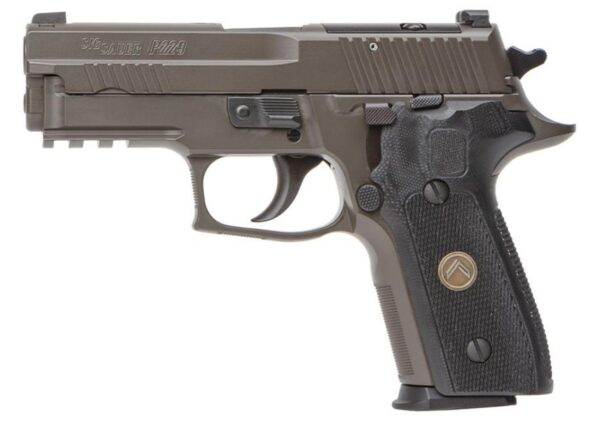
My personal semi-automatics range in size from a 14 ounce 3.1” barreled Kahr 9mm to a 39 ounce 5” barreled Kimber 1911. I have often carried the 1911 concealed under a vest or a jacket, but the compact 9mm is much easier to conceal. How powerful should the self-defense pistol be? I urge people to use as powerful a pistol as they can handle well. I prefer to rely on something that is a proven man-stopper. You also have to consider your likely threat: man or beast. If all else is equal, then the more powerful gun is going to recoil more. For example, I have nearly identical 1911’s in both .45 and 9mm. The 9mm has ridiculously low recoil and is much easier to shoot well quickly than the .45 ACP is.
All things considered, the best “stopping power” is produced by excellent shot placement. Good hits from a modestly powerful handgun are much more effective than misses or poor hits from a very powerful handgun.
History of the .40 S&W and .357 SIG
The .40 S&W was introduced in 1990. It produced similar ballistics to the 10mm cartridge adopted by the FBI, but in a smaller package with less recoil. The .40 offered a lot of power and the pistols could be built on a 9mm-sized frame. Police departments across the country quickly adopted the .40 S&W and within a few years it largely replaced the 10mm and .45 ACP in police use. Private citizens were also impressed because it developed considerably more energy than the 9mm cartridge with less recoil than the 10mm.
By 1994, the .357 SIG was introduced to answer a request from law enforcement for a semi-auto which could duplicate the well-respected power of the 125 grain .357 magnum revolver. Though it was never as popular as the .40 S&W, the agencies who used the .357 SIG were quite impressed with it.
Why then, have both cartridges become far less common in police use? Logistics.
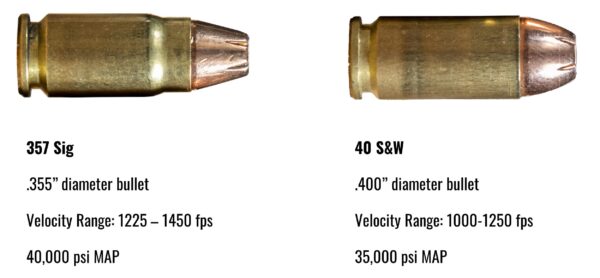
The compact and powerful .357 SIG and .40 have the same case head dimensions with similar overall lengths. Even so, bottlenecked .357 SIG cases cannot be formed by sizing down .40 S&W cases. The .357 SIG case is just slightly longer than the .40 S&W.
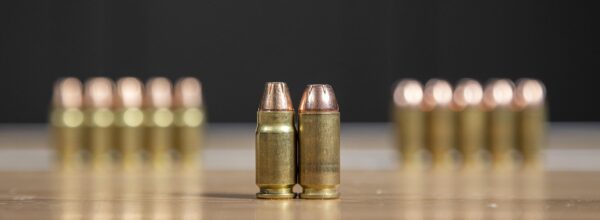
Handloaders must understand that the .357 SIG uses .355” 9mm bullets, not the .357” bullets used in the .357 magnum and .38 special cartridges. The .40 S&W takes the same .400” bullets as the 10mm cartridge. Both rounds utilize small pistol primers and operate at high pressures: maximum average of 40,000 psi for the .357 SIG and 35,000 psi for the .40 S&W.
Ballistics
Both of these intense cartridges were intended for self-defense and have been successfully used for that purpose. The .40 S&W propels a 180 grain bullet to roughly 1,000 fps and lighter 155 grain bullets to nearly 1,200 fps, producing nearly 500 ft.-lbs. of energy at the muzzle.
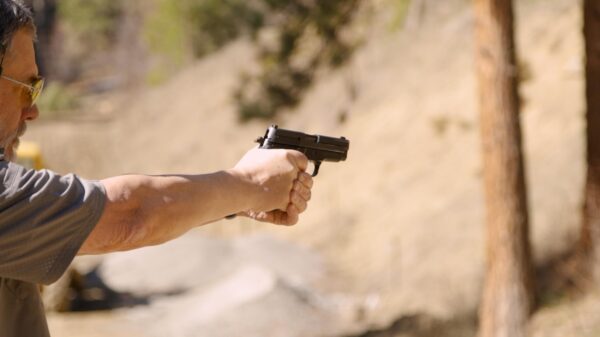
The .357 SIG does approach the famous .357 magnum in terms of velocity and power in factory loads. The 125 grain bullet moves out at 1350 fps, producing an impressive 506 ft.-lbs. of energy at the muzzle. Equally impressive is the fact that it carries an impressive amount of velocity and energy far downrange.

Common Self-Defense .357 SIG and .40 S&W Ammo Types
.357 SIG ammo has become difficult to find and most sporting goods stores I’ve visited don’t stock it. It is available online, but the number of ammunition types has dwindled to a few choices. Fortunately, good defensive ammunition is still being produced. .40 S&W is much more widely available with a good variety of self-defense ammunition offered. I still find .40 S&W stocked on local shelves.
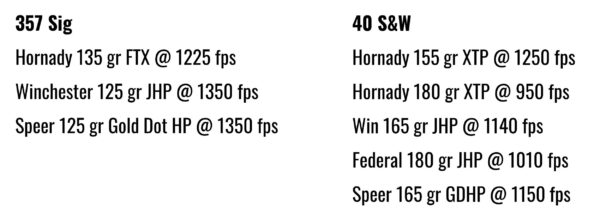
Costs
Ammo for either of these cartridges is more difficult to come by than 9mm. .357 SIG is particularly scarce and both .357 SIG and .40 S&W can be expensive to shoot! Self-defense handgun ammo is expensive to produce, which is reflected in the pricing. When it can be found, factory self-defense .357 SIG ammo costs between $1.50 and $1.60 per round while self-defense .40 S&W rounds range from $1.00 to $1.60 per round! Factory self-defense ammo often features nickel-plated cases for corrosion resistance, advanced bullet designs for impressive performance, flash-reducing powders, and sealed primers. Sending such ammo downrange makes for an expensive shooting session!
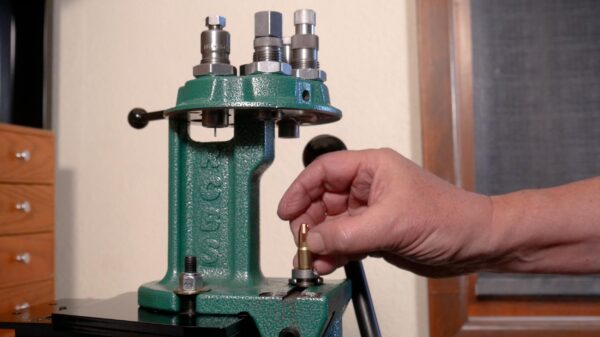
As handloaders, we can build our own high-quality ammo with good expanding bullets for considerably less. Using Hornady XTP bullets and new brass, I was able to load .40 S&W for about $0.69 per round and .357 SIG for $0.65 per round. Reutilizing the brass cases cuts both by about $0.25 per round. I don’t typically load my practice ammunition with self-defense-type bullets, using less expensive plated, cast, or full metal jacketed bullets to save even more.
About the Pistol
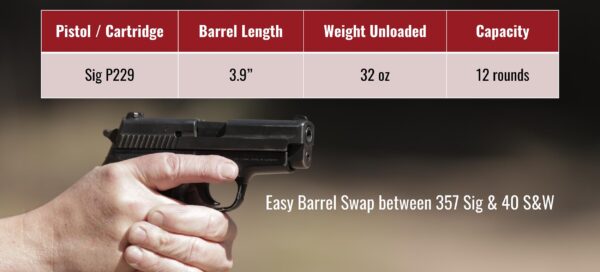
It was terrific to be able to use just one pistol to test both types of ammunition! A simple barrel swap was all that was required to change from .40 to .357 SIG and back.
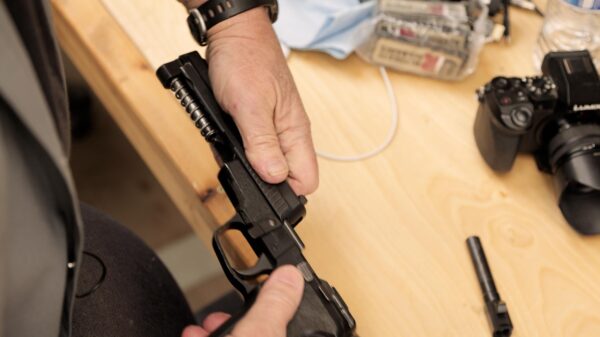
Owners of SIG pistols in .40 S&W can order a new .357 SIG barrel and use their same magazines. The cost of the barrel was about $180 when I checked.
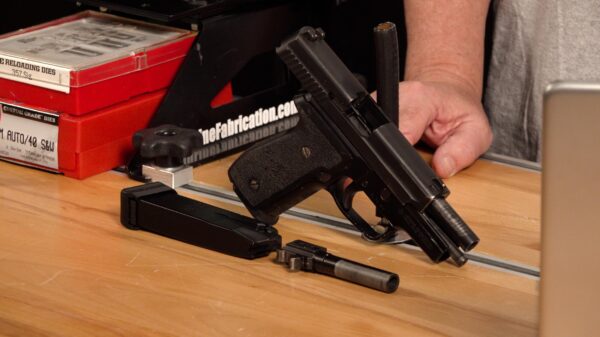
SIG is known for good engineering and excellent quality. The P229 pistol I used for this project was a real pleasure to handle and shoot. It’s virtually weatherproof, has a very comfortable grip, a good trigger, and excellent high-visibility sights. It performed superbly, with no malfunctions with either cartridge.
About the Loads
RCBS builds a compact turret press which I used to load all the ammunition for this project. It’s a quality press, comfortable and easy to use. I prefer to prime off-press so I did remove the priming system for this project.
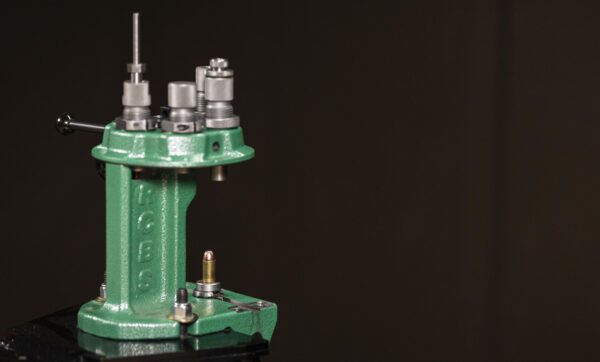
I used Hornady carbide .40 S&W dies. These worked well and included a taper crimp die which assures both a good grip on the bullet and smooth feeding in the pistol. This die set can be used for either the .40 S&W or the 10mm cartridge.
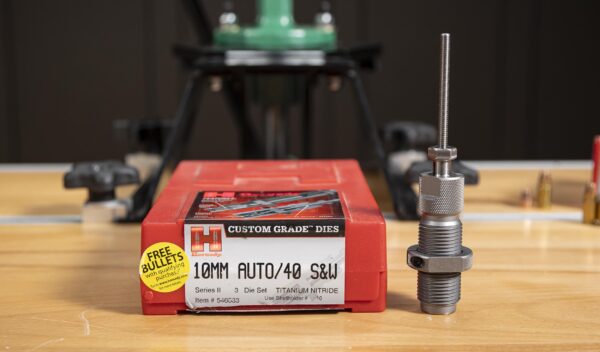
The Lee dies I used for loading the bottleneck .357 SIG cases were steel, so I had to lube each case before sizing. I crimped each case mouth with a collet-style Lee crimp die.
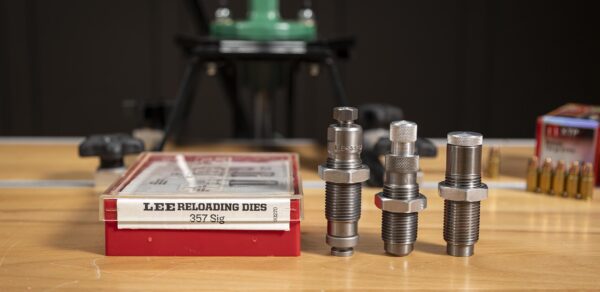
Hornady’s XTP bullet became available over 30 years ago and has earned a great reputation as a self-defense bullet and also for hunting medium game. I chose to use XTP bullets across the board for this comparison, as well as Hodgdon’s Longshot powder and CCI small pistol primers. (I was out of Winchester primers.)
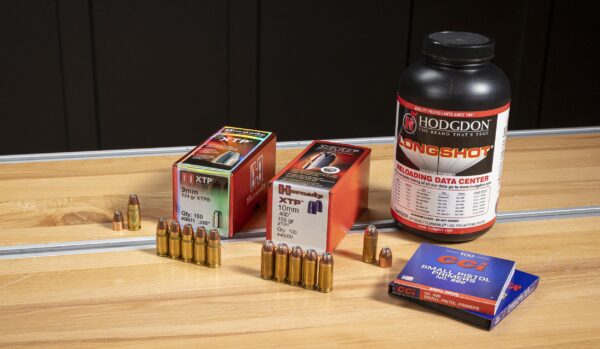
Longshot is an easy powder to like. It produces good velocity and accuracy and seems to be quite clean-burning. It also flows nicely through a mechanical powder measure, making it an excellent choice for reloading on a progressive press. Loading the .357 SIG is a bit different from most handgun reloading I do. Because of the bottleneck case design, I used steel dies that required lubing each case and added a collet-type taper crimp die as a fourth and final die. I prefer to seat and crimp bullets in two separate steps. I used 9.0 grains of Longshot with a 124 grain Hornady XTP. Hodgdon’s Online Reloading Data Center listed a starting load of 8.3 grains and maximum load of 9.3 grains. (Hodgdon’s Annual Manual also has lots of information.)
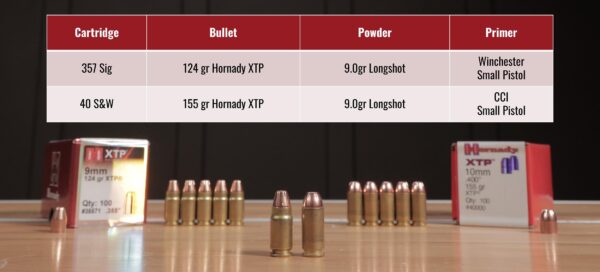
The straight wall .40 S&W is more conventional. I was able to use the same Hornady carbide dies that I’ve also used to load the 10mm cartridge. Hodgdon’s Online Reloading Data Center specified a starting load of 7.5 grains of Longshot with a 155 grain Hornady XTP and a maximum charge of 9.3 grains. I settled on 9.0 grains of Longshot for this cartridge as well.

Remember that self-defense handloads are a controversial subject. Some argue that handloads put an individual at greater risk in both criminal and civil trials after a shooting. (Even in a justified shooting, a civil suit is likely.) Others say the use of handloads poses no legal risks. It pays to research the subject and make your own decision. I prefer to use factory loads for my carry guns, in part because of the low-flash additives to the powder used by many manufacturers. Commercial self-defense ammo is held to high standards, but there can be failures even with ostensibly high-quality commercial ammunition.
Please work up carefully to the level where you are comfortable and safe and do not exceed published load data.
Results
I observed excellent results with both handloads. I was pleased to see that even with a slightly less than a maximum load, the .357 SIG matched the velocity we previously obtained from a 6” .357 magnum revolver using a 125 grain bullet!
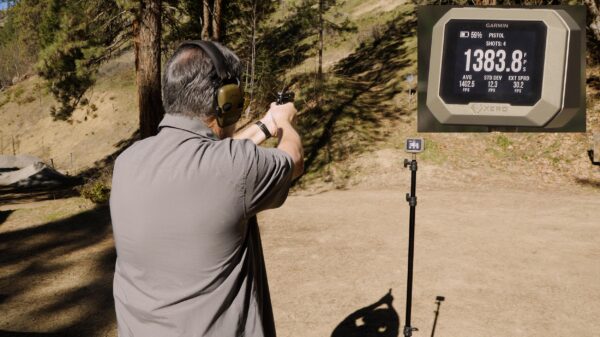
This is exactly what the .357 SIG was designed to do, and it succeeded. Our 6” revolver averaged 1408 fps compared to the 1404 fps we observed from the semi-automatic pistol.
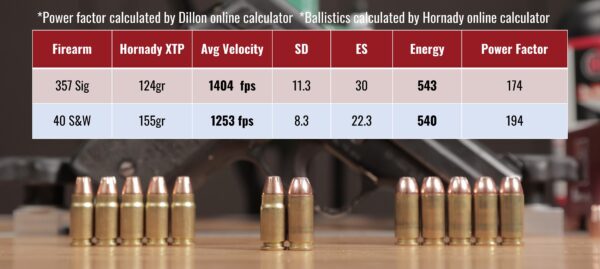
Shooting Impressions
Some of my handgun students have commented on the “snappy” recoil of the .40 S&W, particularly from compact, lightweight pistols. A compact G27 I owned did produce that snappy recoil, but it’s a lot of power from that small package.
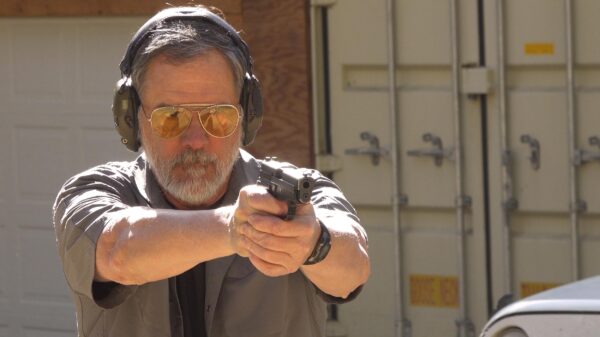
This larger, heavier SIG P229 has a comfortable grip and was easier to shoot than my own GLOCK. It was also slower to shoot with more muzzle flip. The .357 SIG had lighter recoil, higher velocity, and it was faster to recover between shots.
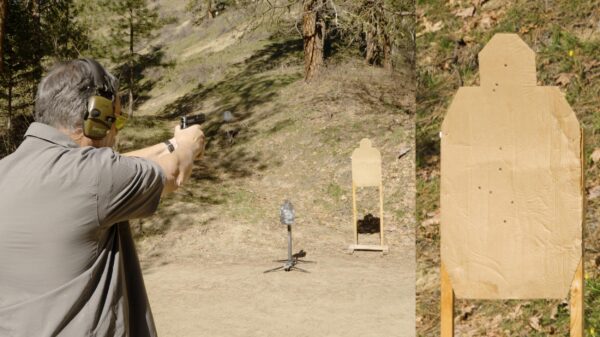
Head-to-Head
The .357 SIG had surprisingly little muzzle flip and light recoil. It was quite easy to control during rapid fire— the sights never left the target while I was shooting. The downside to .357 SIG is the poor supply of ammunition and components. This can be dealt with, but it’s an obstacle.
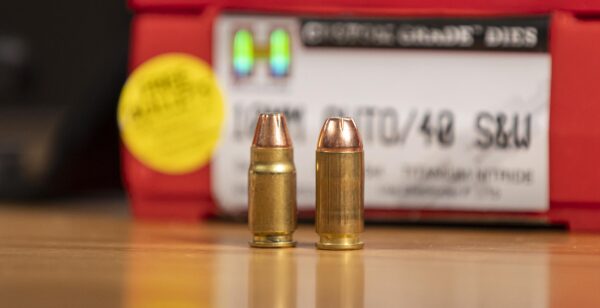
The .40 S&W continues to perform as intended, matching the ballistics of most 10mm cartridges in a smaller package. It offers a lot of proven performance. A firm grip is essential to properly manage recoil and recover quickly for accurate rapid fire. For me, the only real disadvantage of the .40 is that it produces more recoil than the .357 SIG, but it also uses a bigger bullet. I know a few officers who’ve had to shoot an armed suspect with their .40 S&W duty weapons. They each reported it quickly and effectively stopped the threat.
Conclusion
A private citizen could be well served by the .357 SIG. Its mild recoil and excellent practical accuracy are impressive. Overall, it’s too good to let die! I’d recommend purchasing a good supply of factory ammunition and stocking up on brass cases and small primers if you chose to shoot this cartridge. 9mm bullets should remain available in good quantity, given the popularity of the 9×19 cartridge.
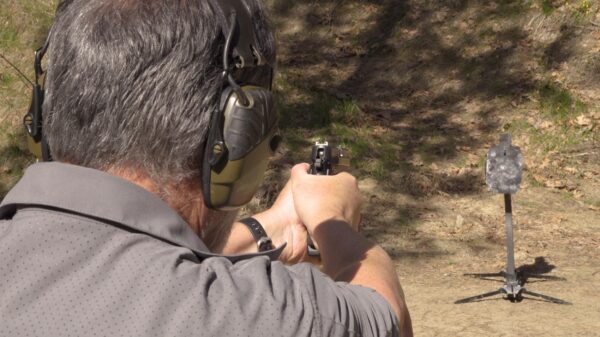
There are a lot of .40 S&W police trade-in pistols on the market now at some very attractive prices. This is a good opportunity to get one and save some money. Many law enforcement pistols haven’t had a lot of shooting and are in good condition except for holster-wear. I’d highly recommend replacing the recoil springs and starting fresh. It might also be worthwhile to buy a .357 SIG barrel for your .40 S&W and enjoy both cartridges!
Get the Gear
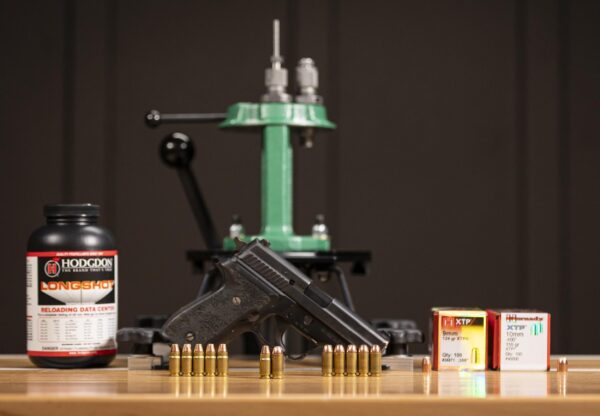
Hornady 9mm .355 Diameter 124 Grain Hollow Point XTP Bullets at Midsouth Shooters Supply
Hornady 10mm .400 Diameter 155 Grain XTP Bullets at Midsouth Shooters Supply
Hodgdon Longshot Smokeless Powder at Midsouth Shooters Supply
Winchester Small Pistol Primers at Midsouth Shooters Supply
CCI #500 Small Pistol Primers at Midsouth Shooters Supply
Starline .357 SIG Unprimed Pistol Brass at Midsouth Shooters Supply
Hornady .40 Smith and Wesson Unprimed Brass at Midsouth Shooters Supply
RCBS Turret Press at RCBS and Midsouth Shooters Supply
Hornady .357 SIG Series IV Specialty 3 Die Set With Zip Spindle at Midsouth Shooters Supply
Lee .357 SIG Steel 3 Die Set With Shellholder at Midsouth Shooters Supply
Hornady 10mm/.40 S&W Series 2 3 Die Set With Taper Crimp at Midsouth Shooters Supply
Hodgdon Annual Manual at Midsouth Shooters Supply
Garmin Xero C1 Pro at Creedmoor Sports and Midsouth Shooters Supply
Don’t miss out on Ultimate Reloader updates, make sure you’re subscribed!
Thanks,
Guy Miner
